
- Fishbourne Roman Palace was practically on the doorstep of the caravan, so we definitely couldn't pass up the opportunity to pay a visit, we cleverly managed to arrive at exactly the same time as an enormous coach, loaded with elderly archeology fans, so while I checked out prices etc. at the entrance (spotting this amusing sign) -
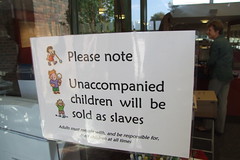
- Flyingpops fought her way past 300 sword wielding school children who were busy shouting and throwing themselves from the top of the enormous spoil heaps (left over from the initial excavation in the 60's when a bloke with a JCB uncovered the first of the mosaics) -

- while teachers blew whistles and tore hair...she managed to find a place to sit quietly until the queue had gone from the tills in the gift shop -

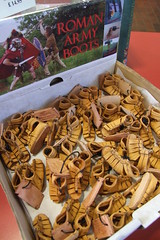
- (which actually had some genuinely interesting little things for sale, rather than the usual rubbers, pencils and pens etc.)...
Anyway, we were told by the lady on the till (after filling out our gift-aid forms) that visitors normally start things off with a trip to the audio-visual room to watch the "Welcome" film, but it was currently full of pensioners, so they suggested a stroll through the museum first -


- which takes you through the history of the site (as far as records and archeology have revealed it's past)...

It all started in 43AD with the construction of several granaries to feed the advancing Roman army (who had cleverly spotted that Chichester Harbour was a rather good place to drop anchor), followed fairly quickly by two large timber framed buildings -
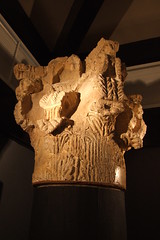
- one of which had these decorated plaster walls (and so was probably a residence for a person of some significance) -
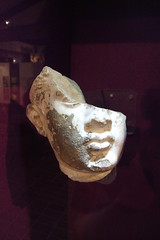
Somewhere between 73AD and 92AD construction of the larger palace was started, and it is widely accepted that it was a high profile residence for one Sallustius Lucullus (son of British Prince Adminius), this could have been a statue of him (well, part of it anyway)...although there are other theories (obviously)...
From there we wandered over to the A/V room and watched the Tony Robinson narrated film (after being shown in and given our "the emergency exits are here and here" talk by the terribly amusing gentleman from the shop "Be warned, we have had a fire on the premisies..." (pause for comedic emphasis) "...circa 270AD" (snort, guffaw) -
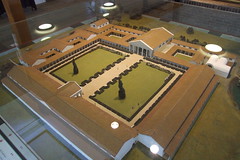
It's a huge site, although you really only begin to appreciate it when you get out into the gardens (they have restored just a tiny fraction of the northern bit, but more on that later), the building, as a whole is by far the largest (known) Roman residence north of the Alps, in all around 150 meters square, which renders the floor plan comparable in size to Buckingham Palace, just to give you an idea (although obviously nothing like the same in height)...this huge building -
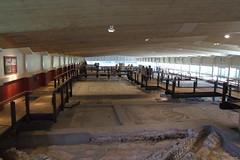

- contains the remains of just one tiny section of one of the wings (most of them having been destroyed by years and years of agricultural work in the area (not to mention the odd burial - cut right through the Roman archeology) -

There is a lot to see, it's nothing like as well preserved as say, the site at Bath, but there's still plenty -

- an unfinished hypocaust, some staggeringly well preserved mosaic floors (including the famous Dolphin one uncovered in that first, lucky test pit when digging began)...

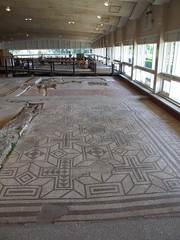
Something I found particularly interesting was where flooring has gradually subsided, settling into much older ditches as the material used to pad them (to what the Romans believed was permanently) flat has slowly compressed over the years creating some fascinating undulations...
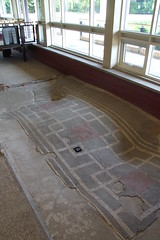
Outside, concrete blocks mark the outline of as much of the rest of the site as is possible (thanks to pre-existing surrounding homes, schools and busy roads) -

- and then into the gardens, laid out exactly as they were when the palace was in use, Tony Robinson pointed out how this would be most Briton's first look at a cultivated garden, speculating the terror they may have felt walking through "nature tamed" along the avenue towards the imposing audience chamber at the far end, and it must have been an impressive sight, but I do sort of think by the time the Romans arrived the Celts might have worked out a little bit about farming (but anyway) -
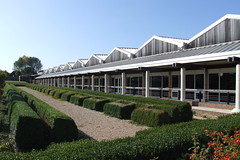


The gardens also contain a number of unexpected things that the Romans were known to be propagating -

- like figs and (very sour, I tried) grapes -

- and then you find yourself facing the steps up into the audience chamber (although they don't look original to me)... ;)

...and it's easy to imagine yourself as an ancient Briton, approaching your meeting with Sallustius Lucullus, a flutter in your tummy...!
A very enjoyable afternoon... ;)


- which takes you through the history of the site (as far as records and archeology have revealed it's past)...

It all started in 43AD with the construction of several granaries to feed the advancing Roman army (who had cleverly spotted that Chichester Harbour was a rather good place to drop anchor), followed fairly quickly by two large timber framed buildings -

- one of which had these decorated plaster walls (and so was probably a residence for a person of some significance) -

Somewhere between 73AD and 92AD construction of the larger palace was started, and it is widely accepted that it was a high profile residence for one Sallustius Lucullus (son of British Prince Adminius), this could have been a statue of him (well, part of it anyway)...although there are other theories (obviously)...
From there we wandered over to the A/V room and watched the Tony Robinson narrated film (after being shown in and given our "the emergency exits are here and here" talk by the terribly amusing gentleman from the shop "Be warned, we have had a fire on the premisies..." (pause for comedic emphasis) "...circa 270AD" (snort, guffaw) -

It's a huge site, although you really only begin to appreciate it when you get out into the gardens (they have restored just a tiny fraction of the northern bit, but more on that later), the building, as a whole is by far the largest (known) Roman residence north of the Alps, in all around 150 meters square, which renders the floor plan comparable in size to Buckingham Palace, just to give you an idea (although obviously nothing like the same in height)...this huge building -


- contains the remains of just one tiny section of one of the wings (most of them having been destroyed by years and years of agricultural work in the area (not to mention the odd burial - cut right through the Roman archeology) -

There is a lot to see, it's nothing like as well preserved as say, the site at Bath, but there's still plenty -

- an unfinished hypocaust, some staggeringly well preserved mosaic floors (including the famous Dolphin one uncovered in that first, lucky test pit when digging began)...


Something I found particularly interesting was where flooring has gradually subsided, settling into much older ditches as the material used to pad them (to what the Romans believed was permanently) flat has slowly compressed over the years creating some fascinating undulations...

Outside, concrete blocks mark the outline of as much of the rest of the site as is possible (thanks to pre-existing surrounding homes, schools and busy roads) -

- and then into the gardens, laid out exactly as they were when the palace was in use, Tony Robinson pointed out how this would be most Briton's first look at a cultivated garden, speculating the terror they may have felt walking through "nature tamed" along the avenue towards the imposing audience chamber at the far end, and it must have been an impressive sight, but I do sort of think by the time the Romans arrived the Celts might have worked out a little bit about farming (but anyway) -



The gardens also contain a number of unexpected things that the Romans were known to be propagating -

- like figs and (very sour, I tried) grapes -

- and then you find yourself facing the steps up into the audience chamber (although they don't look original to me)... ;)

...and it's easy to imagine yourself as an ancient Briton, approaching your meeting with Sallustius Lucullus, a flutter in your tummy...!
A very enjoyable afternoon... ;)

5 comments:
This place has certainly changed since I was there some years ago, glad you enjoyed your visit.Did they have the child's ring found in the garden on display? That made the family who lived there seem very real.
There were all sorts of finds in the museum, will have to keep an eye out for the ring when we return (we have free entry for a year because of the gift aid)...!
Hrm, look anything like a JCB footprint on those floors?
Horrifyingly, yes... :(
JCB! Perhaps it was Time Teamed.
Thanks for the pics and write-up. More enjoyable than when I actually went there many years ago.
Post a Comment